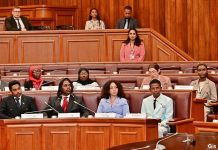Africa-Press – Mauritius. The world is gearing up for the 29th Conference of the Parties on Climate Change (COP 29) which will be held in Baku, Azerbaijan, from November 11 to 22, 2024.
Climate Finance, which is very vital for Africa, will be among the central topics during this conference. It is expected that COP 29 will accelerate the development of better global carbon markets.
According to Excellent Hachileka, a programme specialist, climate strategies and policy team at UNDP, across Africa, carbon markets are emerging as a powerful tool to combat climate change.
Hachileka argues that these markets entail translating volumes of carbon dioxide reduced through mitigation measures into tradable carbon credits -a valuable commodity that countries, companies and individuals can sell and purchase to offset their emissions.
As the international community prepares to gather for COP29, Africa must put its best foot forward and get it right for the continent.
This task falls in the hand of Africa Group of Negotiators Experts Support (AGNES). This is a not-for-profit think tank of African experts and practitioners that provides evidence-based technical support to the African Governments.
The AGNES was created in 2015 to provide scientific expertise and evidence to inform a common African position in climate change negotiations.
Africa is pegging its hope on Agnes to lift the continent’s presence in the global carbonmarket. Historically, Africa had a limited presence in the global carbon market – only 3 per cent of Clean Development Mechanism (CDM) carbon credit projects originated from Africa as of 2022.
CDM is a United Nations-run program that helps countries reduce greenhouse gas emissions by supporting projects in developing countries.
According to a recently released report by Centre for Science and Environment (CSE), Africa is experiencing growth in voluntary carbon markets.
CSE says in 2024, one-fifth of the projects listed in top carbon market registries have been coming from Africa, with the bulk of them focused on two main areas: forestry and land use, and community-based projects, particularly those involving household devices like improved cookstoves.
What are Carbon Markets?
Carbon markets are systems that price carbon emissions and create economic incentives for governments and businesses to either reduce their emissions or pay for reductions made by others.
Essentially, buyers—including countries, companies, or individuals purchase certificates that represent financial support for activities that reduce carbon emissions, such as growing trees.
These certificates are used by buyers to ‘offset’ their emissions. Buyers are matched with sellers who perform the activities that reduce emissions, generating sellable certificates that are quantified based on the amount of emission reduction achieved.
However, they can be divided into two main categories: compliance markets, where industries participate to meet government emission standards and are structured and enforced by legislation, and voluntary markets.
In voluntary markets, participants choose to engage in carbon trading beyond regulatory requirements and the market is largely unregulated.
Although Africa does not have compliant carbon markets, the voluntary carbon market (VCM) has grown significantly on the continent.
Key registries of the VCM, such as Verra’s VCS and the Gold Standard, which together account for over 95 per cent of Africa’s voluntary carbon market projects, reflect this growth.
According to CSE, as of March 2024, 1,925 projects across Africa were listed on these two leading voluntary carbon market registries.
Of these, 882 projects had been issued carbon credits, totaling approximately 278 million; out of these, 140 million carbon credits had been retired.
Some of the earliest carbon market projects in Africa emerged in the late 1990s, beginning with forest conservation initiatives in East Africa.
One of the first REDD+ projects in the voluntary carbon market was initiated during this period: the Kasigau Corridor REDD+ Project in Kenya.
REDD+ stands for reducing emissions from deforestation and forest degradation in developing countries.
Another notable project in Kenya, the Mikoko Pamoja project, was among the first in the world to issue carbon credits for mangrove conservation.
Most of the carbon credit projects in Africa are concentrated in two main areas: forestry and land use, and community-based projects particularly those involving household devices like improved cookstoves.
These sectors are the leading carbon credit issuers across the continent.
How do they work? How relevant are they for both the community and the climate?
Clean cookstove projects:
Clean cookstove projects in the voluntary carbon market (VCM) involve partnerships between carbon credit project developers and manufacturers or distributors of energy-efficient cookstoves.
These stoves are provided to communities, often at a subsidised price or sometimes for free. The idea is that these cookstoves use less fuel and produce fewer emissions compared to traditional stoves, reducing the amount of carbon released into the atmosphere.
Project developers then calculate the amount of carbon emissions avoided by using these cleaner stoves and claim carbon offsets for the reduction.
These offsets are certified by voluntary carbon offsetting standards and can be sold in the voluntary carbon markets. The revenue generated from selling these offsets helps fund the project and also generates profits for the developers.
Cookstove challenges
According to the Centre for Science and Environment, a study done in India on cookstove projects identified several issues in the design and implementation of these initiatives.
One of them was lack of transparency regarding the ownership of carbon credits. Locals were often unaware that they had signed over their carbon rights to project developers.
Another issue was that in some cases, households had even made payments to receive the cookstoves, unaware that the cookstoves were generating carbon credits for the project developers.
There was also inadequate monitoring and verification.
Despite claims of regular surveys, many households reported minimal or no follow-up from the project developers. The study also criticised the role of third-party validators, who appeared to give projects a clean chit despite apparent discrepancies in their field visits.
The study questioned whether these projects genuinely benefited the communities involved.
Many locals found the improved cookstoves inconvenient or infrequently used, undermining the projected environmental benefits.
The financial benefits derived from carbon credits appeared to disproportionately favor project developers over local communities.
Forestry and land
Forestry and land use carbon credit projects are designed to sequester/confiscate or take away carbon dioxide (CO2) from the atmosphere through changes in land management practices.
Forestry and land use-based projects make up about one-fifth of all projects in the voluntary carbon market. Centre for Science and Environment says about 40 per cent of the carbon credits issued have gone to these projects.
Some of the examples of interventions under forestry and land use are afforestation and reforestation. These involve planting trees on land that was not previously forested (afforestation) or replanting trees in deforested areas (reforestation).
Another project under forestry and land use is avoided deforestation. These projects aim to prevent deforestation or degradation of existing forests.
By protecting forests from being cut down, the project avoids the release of carbon stored in the trees. In this list also is sustainable forest management which involves managing forest resources in a way that maintains their biodiversity, productivity, and ecological processes while still allowing for timber and other resource extraction. Proper management helps maintain the forest’s carbon storage capacity.
Agroforestry has also been identified as part of forestry and land use carbon credit projects. This involves integrating trees and shrubs into agricultural landscapes, combining forestry and farming.
Listed also is wetland restoration. Wetlands store large amounts of carbon in their soil and vegetation. The last project is grassland management where such projects enhance carbon sequestration by improving grazing practices, restoring degraded lands, and managing soil health.
According to Centre for Science and Environment, there are 175 forestry and land use-based projects across Africa in four voluntary carbon market registries as of August 2024.
The registries are Verified Carbon Standard (VCS), Gold Standard, Architecture for REDD+Transactions; The REDD+ Environmental Excellence Standard (ART TREES), and AmericanCarbon Registry (ACR).
Carbon credits issued so far are mostly in the Democratic Republic of Congo, Kenya, Zimbabwe, Zambia, and Ethiopia.
Africa and Blue Carbon Land Deals
Also on the table is the Blue Carbon Land Deals.
Towards the end of 2023, Blue Carbon, a Dubai-based decarbonization company, entered into a framework of collaboration (FOC) with the State Department of Environment and Climate Change of Kenya, which reportedly granted Blue Carbon access to millions of hectares of Kenyan territory for carbon credit production.
This deal added to a series of similar agreements with African nations, including Liberia, Tanzania, Zambia, and Zimbabwe, covering a total of 24.5 million hectares, regional news source Middle East Eye (MEE) reported.
A series of carbon offset agreements signed by the UAE-based company in 2023 garnered significant attention before and during CoP 28.
These deals with African governments involve the transfer of carbon rights over vast expanses of land for reforestation, forest restoration, and conservation efforts.
The agreements aim to support the government’s efforts to conserve and manage hectares (ha)of forest resources.
What are the concerns?
One of the largest carbon credit projects registered in Africa was the Kariba REDD+ project in Zimbabwe. By early 2023, the project, which was registered in 2011, had sold 28.8 million credits to well-known global companies.
In March 2023, Bloomberg investigated the project and found that while the project fetched over €100 million, most of the money had gone to the project developers, rather than to the community undertaking efforts to prevent deforestation.
In some cases, carbon credit projects have led to the displacement of communities, either through direct eviction or by restricting access to lands they traditionally use.
Another issue is the inequitable distribution of benefits. Despite being the custodians of the land, communities often receive either a small portion or nothing out of the financial benefits generated by carbon credit projects.
This has led to concerns about fair compensation and benefit-sharing. The complexity of carbon markets and the involvement of multiple intermediaries often obscure the flow of funds, making it difficult for local stakeholders to understand how much they should rightfully receive.
These are the issues AGNES must priorities as Africa prepares for the Baku, Azerbaijan.
Source: The Star
For More News And Analysis About Mauritius Follow Africa-Press







